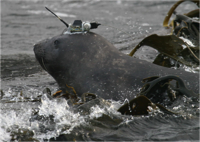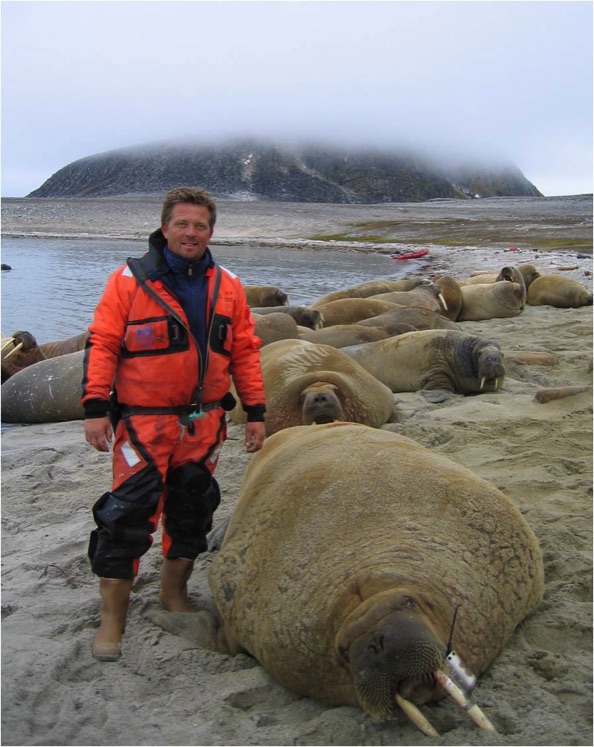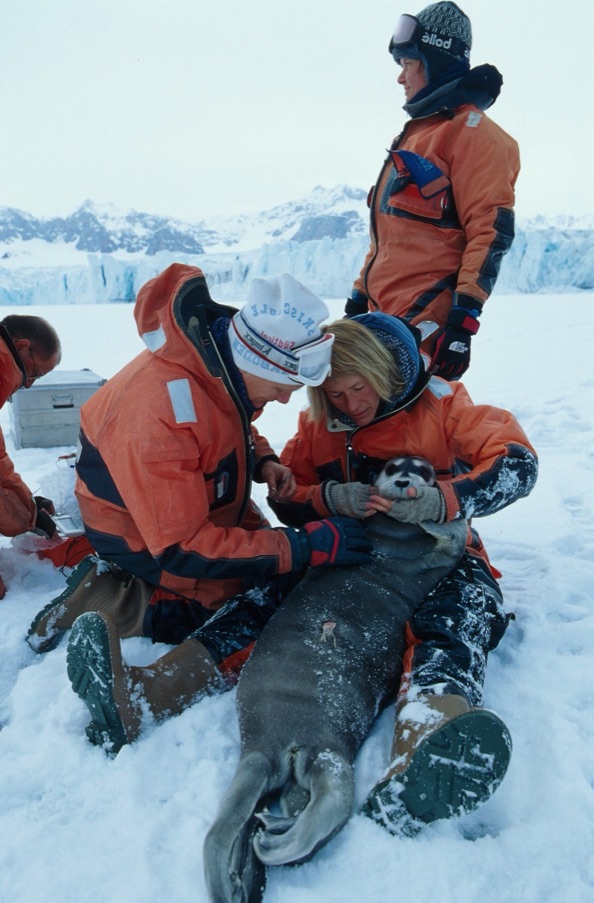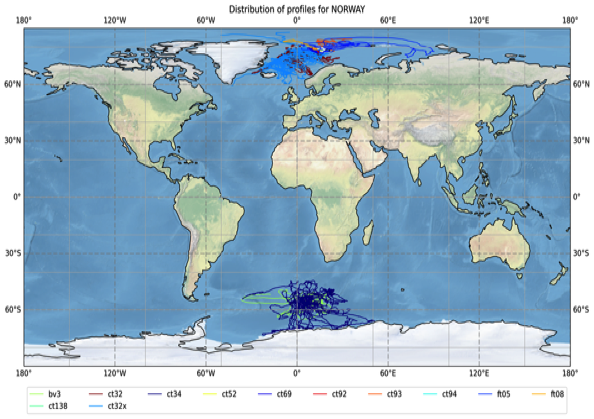
Over 800,000 vertical profiles of Temperature and Salinity have been collected since 2004 in the World Ocean by attaching tags on marine mammals, such as Southern elephant seals.
In this website, you will find information about the marine mammal tagging programs, and an access point to the publicly available databases.
Please let us know if you are using our data. You can contact us by mail to info@meop.net if you have any question.
The MEOP data portal
Content of the website
Norway
Deployment sites: Svalbard, Lofoten, Bouvet Island
Supporting institutions: the Norwegian Polar Institute and Research Council of Norway
Actors: Kit Kovacs, Christian Lydersen and Andrew Lowther (Norwegian Polar Institute), Martin Biuw and Ole Anders Nøst (Akvaplan-Niva)




MEOP Norway deployed 3 tags on hooded seals in the summer moulting season in July of 2007 in the West Ice. This was followed by the deployment of 17 additional tags on this species in the breeding season in March of 2008 (a little to the south of the moulting deployments), just north of Jan Mayen Island. Although all tags functioned well from a technical perspective from the first immersion – one young animal’s record in March terminated abruptly six hours after it had gone to sea. This was presumably not a technical issue, but rather a biological mishap - from the seal’s perspective (i.e. the pup became prey rather than a predator).
Data is still very actively incoming from the northern deployments of MEOP Norway, and data-flow will hopefully continue until July of 2009 from some of these tags. But, to date the MEOP Norway hooded seal deployments cover over 1,728 days of seal tracking, which have provided over 6,000 oceanographic profiles and 100,000 ocean data points. We are in the “early days” with respect to data analyses, but these seals are certainly doing their job – diving to maximum depths of over 1km for durations up to 87 min. They have travelled broadly and provided excellent oceanographic coverage of a vitally important ocean sector – the Fram Strait (and beyond). The hooded seals have shocked us with the extent of their distribution, reaching 89o N and 59o N to the south.
Subset of hooded seals tracks from MEOP – Norway deployments of CTD-SRDLs.Image: MEOP-Norway project team
Our Southern Ocean deployments in MEOP Norway also went very well. All 20 instruments in the programme were successfully glued onto southern elephant seals (with just one member of the deployment team needing stitches) in the moulting period in late January and early February on Bouvetøya. Similar to the situation in the north, we lost one tag, and its bearer, on the day of deployment – not to marine predation in this case – but rather to a landslide! The 19 tags that went to sea have all provided valuable data and can only be considered an “all-star success”. The animals have travelled throughout a virtually unknown sector of the Southern Ocean reporting over 14,000 ocean profiles from a region where 186 Argos buoys have only managed to document a 10th of this volume of ocean data. The seals have travelled from 44o S right down to the Antarctic Continent, with excursions up to 2,500 km away from Bouvetøya by individual animals. These deep diving seals have gone down to maximum depths of over 1500 m for periods over 1.5 hrs. To date, we have documented over 4,600 elephant-seal-days at sea within MEOP Norway. Our elephant seals are now coming ashore for the first time, for the upcoming breeding season. We hope that some of the tags will continue to function when the animals return to sea, until the moult in the New Year.
Our MEOP oceanographers have begun working with calibration efforts on the Southern Ocean data, and the seal-ocean-data is standing up well to their scrutiny. It is remarkably similar to ship-based CTD measurements for the few expeditions that took place in this huge ocean sector in 2007/2008’s austral summer.
1) an unexpectedly broad distribution area covered by both study species
2) a vast degree of individual variation displayed in terms of foraging strategies among individuals
3) an unexpectedly high degree of geographic mixing among deployment colonies within the International MEOP programme in the Southern Ocean. Foraging ranges from different colonies overlap and some animals have arrived at different islands to breed compared to where they moulted.
Kit with bearded seal pup. Image: Kit M. Kovacs & Christian Lydersen
Kit has worked with marine mammal research for the past 30 years, commencing fieldwork in the high Arctic while she was an undergraduate. She has worked extensively with most of the northern phocid seal species as well as walrus, Antarctic fur seals, southern elephant seals, narwhal, white whales and bowheads during her career. Kit is an ecologist that focuses primarily on population dynamics, behavioural ecology and evolutionary biology. “Climate change impacts” is a theme that dominates much of her current research activity. Kit has the academic rank of Full Professor and holds a 20% university faculty position at University Studies on Svalbard (UNIS) in addition to her governmental position as Biodiversity Research Programme Leader for the Norwegian Polar Institute (NPI). She has published ~140 peer-reviewed journal articles, seven books and numerous popular articles, scientific reports and book chapters – most in the field of marine mammalogy. Kit is currently the Chair of the IUCN Pinniped Specialist Group, an arctic cetacean advisor for the American Cetacean Society and Past-President of the International Society for Marine Mammalogy.
Christian after having deployed a satellite transmitter to a male walrus in Svalbard. Image: Kit M. Kovacs & Christian Lydersen
Christian is a Research Scientist at the Norwegian Polar Institute in Tromsø, Norway, with a Dr. Philos from University of Oslo, Norway. He has worked with marine mammals in the Arctic for about 30 years, mainly in Svalbard. He has published extensively in the scientific literature in population biology, ecology, physiology, ecotoxicology, biologging and other topics involving a wide diversity of arctic marine mammal species (walrus, ringed, bearded, harp, hooded and harbour seals, beluga, narwhal and bowhead whales), as well as having published several popular and academic books. Currently he is involved in studies of walruses, ringed, hooded and harbour seals in the High Arctic (Svalbard) in addition to studies of southern elephant seals and Antarctic fur seals in the Southern Ocean.
Martin weighing a female elephant seal prior to attaching a CTD-SRDL (Bouvetøya, Feb 2008). Image: Aline Arriola.
Martin has been involved with research on marine mammals since 1995. Most of his work has been conducted in the sub-Antarctic and the Antarctic on various seal species, and he has also worked on penguins and Southern Ocean seabirds. Martin was intimately involved in the development of the current generation of the CTD-SRDL instruments, and conducted some crucial field suitability testing (Oops, it broke..), and was one of two post-doctoral researchers on the UK component of the SEaOS program (Southern Elephant seals as Oceanographic Samplers). Martin has specialised in the eco-physiology and foraging ecology of southern elephant seals. The elephant seal is a uniquely suitable species for this kind of work, and results can be applied to seals in general. One overall objective of his research is to work towards developing a comprehensive framework for understanding the life history of long-ranging marine predators, and how these are fundamentally shaped by a range of factors, from physiology to environmental variation.
Ole Anders has worked with physical oceanography in the Arctic and Antarctic for nearly 20 years. In Antarctica he has worked with sub ice shelf- and coastal circulation since the start of his career. Currently he is leading a large multidisciplinary project with the aim to understand the processes responsible for melting of the Fimbul Ice Shelf in Dronning Maud Land. This project includes physical oceanography and glaciology as well as biology through MEOP. In the Arctic, Ole Anders is working with the dynamics of the large scale circulation. He has constructed simplified, although realistic, models of the circulation in the Nordic Seas and Arctic Ocean. The focus of this work has been the effect of sloping bottom topography, which has a dominating effect of the large scale circulation in the Nordic Seas and Arctic Ocean. In his work Ole Anders is combining observational data, idealized numerical modeling, laboratory experiments in rotating basins and geophysical fluid dynamics. Ole Anders has been on several expeditions to the Antarctic and participating in numerous cruises to the Arctic.

